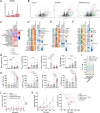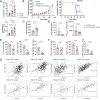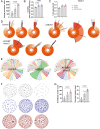Sculpting the tumour microenvironment by combining radiotherapy and ATR inhibition for curative-intent adjuvant immunotherapy
- PMID: 39134540
- PMCID: PMC11319479
- DOI: 10.1038/s41467-024-51236-6
Sculpting the tumour microenvironment by combining radiotherapy and ATR inhibition for curative-intent adjuvant immunotherapy
Abstract
The combination of radiotherapy/chemoradiotherapy and immune checkpoint blockade can result in poor outcomes in patients with locally advanced head and neck squamous cell carcinoma (HNSCC). Here, we show that combining ATR inhibition (ATRi) with radiotherapy (RT) increases the frequency of activated NKG2A+PD-1+ T cells in animal models of HNSCC. Compared with the ATRi/RT treatment regimen alone, the addition of simultaneous NKG2A and PD-L1 blockade to ATRi/RT, in the adjuvant, post-radiotherapy setting induces a robust antitumour response driven by higher infiltration and activation of cytotoxic T cells in the tumour microenvironment. The efficacy of this combination relies on CD40/CD40L costimulation and infiltration of activated, proliferating memory CD8+ and CD4+ T cells with persistent or new T cell receptor (TCR) signalling, respectively. We also observe increased richness in the TCR repertoire and emergence of numerous and large TCR clonotypes that cluster based on antigen specificity in response to NKG2A/PD-L1/ATRi/RT. Collectively, our data point towards potential combination approaches for the treatment of HNSCC.
© 2024. The Author(s).
Conflict of interest statement
E.C. and S.A.S. are employees and stockholders of AstraZeneca. The remaining authors declare no competing interests.
Figures







References
-
- Burtness, B. et al. Pembrolizumab alone or with chemotherapy versus cetuximab with chemotherapy for recurrent or metastatic squamous cell carcinoma of the head and neck (KEYNOTE-048): a randomised, open-label, phase 3 study. Lancet394, 1915–1928 (2019). - PubMed
-
- Cohen, E. E. W. et al. Pembrolizumab versus methotrexate, docetaxel, or cetuximab for recurrent or metastatic head-and-neck squamous cell carcinoma (KEYNOTE-040): a randomised, open-label, phase 3 study. Lancet393, 156–167 (2019). - PubMed
-
- Lee, N. Y. et al. Avelumab plus standard-of-care chemoradiotherapy versus chemoradiotherapy alone in patients with locally advanced squamous cell carcinoma of the head and neck: a randomised, double-blind, placebo-controlled, multicentre, phase 3 trial. Lancet Oncol.22, 450–462 (2021). - PubMed
-
- Tao, Y. et al. Pembrolizumab versus cetuximab concurrent with radiotherapy in patients with locally advanced squamous cell carcinoma of head and neck unfit for cisplatin (GORTEC 2015-01 PembroRad): a multicenter, randomized, phase II trial. Ann Oncol.34, 101–110 (2023). - PubMed
MeSH terms
Substances
Grants and funding
LinkOut - more resources
Full Text Sources
Molecular Biology Databases
Research Materials
Miscellaneous

